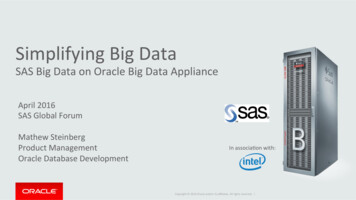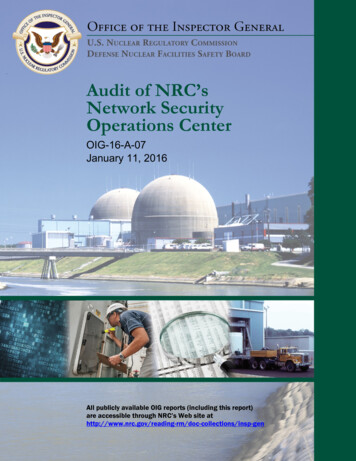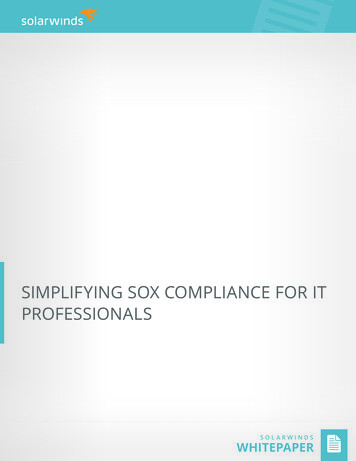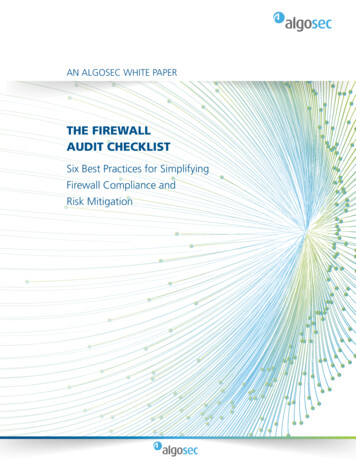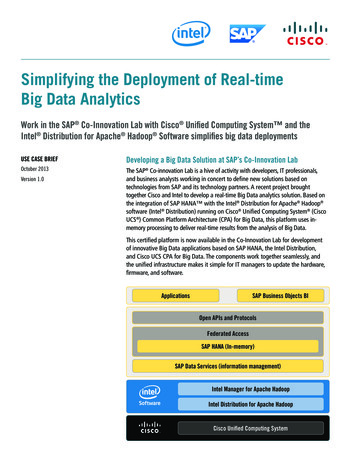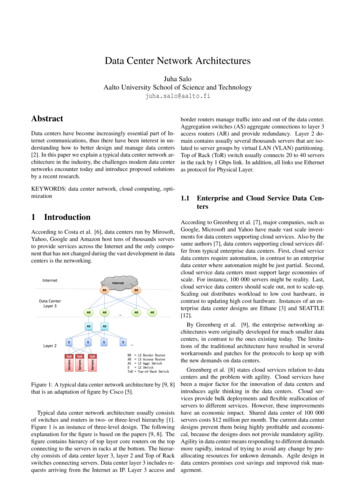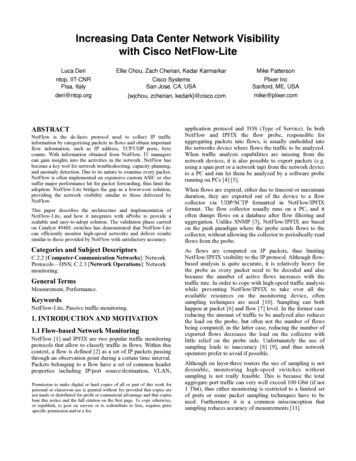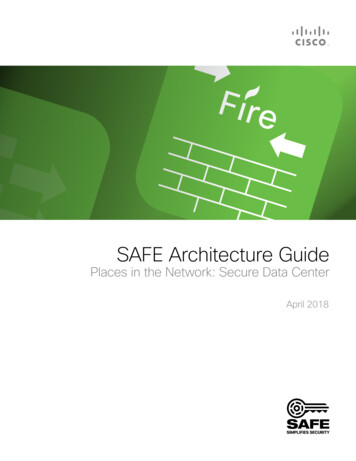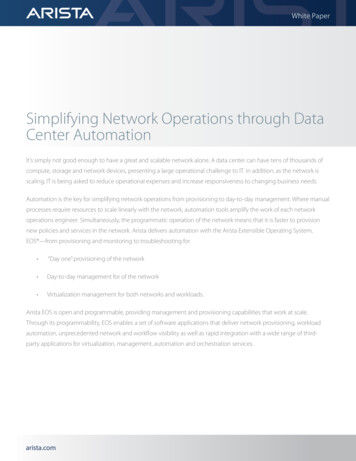
Transcription
White PaperSimplifying Network Operations through DataCenter AutomationIt’s simply not good enough to have a great and scalable network alone. A data center can have tens of thousands ofcompute, storage and network devices, presenting a large operational challenge to IT. In addition, as the network isscaling, IT is being asked to reduce operational expenses and increase responsiveness to changing business needs.Automation is the key for simplifying network operations from provisioning to day-to-day management. Where manualprocesses require resources to scale linearly with the network, automation tools amplify the work of each networkoperations engineer. Simultaneously, the programmatic operation of the network means that it is faster to provisionnew policies and services in the network. Arista delivers automation with the Arista Extensible Operating System,EOS —from provisioning and monitoring to troubleshooting for “Day one” provisioning of the network Day-to-day management for of the network Virtualization management for both networks and workloads.Arista EOS is open and programmable, providing management and provisioning capabilities that work at scale.Through its programmability, EOS enables a set of software applications that deliver network provisioning, workloadautomation, unprecedented network and workflow visibility as well as rapid integration with a wide range of thirdparty applications for virtualization, management, automation and orchestration services.arista.com
White PaperThere is a growing need for a fundamental change to the provisioning of networks just like server provisioning has evolved overthe years by leveraging automation tools such as Puppet and Chef. The demand for agility and deployment at scale with regards toprovisioning and network operations requires a new level of automation and integration with current data center infrastructure. Theunderlying design of the network operating system provides the architectural foundation to meet these requirements.Arista EOS: Foundation for Programmability and AutomationArista EOS is the industry’s most advanced, open and extensible network operating system. EOS combines modern-day software andoperating system (O/S) concepts including transparently restartable processes, open platform development, an unmodified Linuxkernel, and a stateful, programmable publish/subscribe database model for switching state. The Arista EOS software frameworkguarantees consistent operations, workflow automation and high availability.Figure 1: Arista EOS ArchitectureKey advantages of using an unmodified Linux kernel include the following: Retaining benefits from Linux community development including bug fixes, feature updates and security updates Full Linux capabilities such as using standard tools right out of the box, installing additional tools through RPM packages,running third party Linux applications, and creating custom tools with bash, perl and python. The ability to use the same Linux-based toolsets to manage network nodes as for server and compute nodes.Arista EOS has a unique multi-process, state-sharing architecture that separates state information and packet forwarding fromprotocol processing and application logic. This modular architecture enables stateful fault isolation, stateful fault repair, securityexploit containment as well as in-service software updates.Arista EOS offers the following features that support automation: Modular, state-sharing architecture that enables stateful fault isolation and fault repair Single binary EOS image that can be deployed across any family of products. This improves the testing depth on eachplatform, reduces time-to-deployment, and keeps features and bug resolution compatibility across all platforms. Programmable at all layers: Linux kernel, hardware forwarding tables, virtual machine orchestration, switch configuration,provisioning automation, and advanced monitoring Open Linux and EOS access with the flexibility and choice to provide authorized and secure access through TACACS &RADIUS AAA featuresarista.com
White PaperProvision a “Day One” NetworkScaling provisioning as the network grows is a challenge. Often manual configuration is used to provision the network. However,as the network grows, an increasing number of individuals are involved, and often in the coordination and communication of theprocess, errors get introduced. Simultaneously, businesses are more reliant than ever on data and services being delivered fromtheir data center; data center outages have even an even larger impact today. Automation of initial and ongoing provisioning andnetwork monitoring are key strategies for reducing the human error component.Arista Zero Touch Provisioning (ZTP)A first step in automating the data center is the ability to provision an existing or new green field network quickly andprogrammatically. Arista EOS Zero Touch Provisioning (ZTP) automates the configuration of a new or replacement switch withoutuser intervention or requiring a network engineer with a serial console cable.With ZTP, a switch loads its image and configuration from a centralized location within the network. Using standards based protocols(e.g. DHCP, T/FTP, HTTP), the network can be rapidly provisioned. Administrators can programmatically tailor boot configurationsbased on a variety of parameters, meeting the needs of even the most complex data center deployments.DHCP ServerBoot ConfigServervSphereFigure 2: Zero Touch Provisioning for a new or replacement switchZTP automates the deployment of network switches such that it is simply a case of racking the switches, cabling them and poweringthem on. ZTP eliminates manual configuration for provisioning changes and operating system upgrades. Combined with otherArista solutions, like Arista EOS VM Tracer, automatic VLAN configuration, data center managers can fully automate the bring-up ofnetwork elements and virtual servers.Table 1: Operational savings moving from manual to automated, ZTP-based provisioning for 10K portsOperational MeasuresManualAutomated with ZTPTime-to-Provision2 to 3 days15 minutesEngineering Resources2 to 3 engineers1 engineer% Errors10 to 20%0%With ZTP, a single engineer can program the configuration updates. With manual configuration, several network engineers arerequired to roll-out the changes within an acceptable time frame, with each manual change creating an opportunity for introducingerror. Automated provisioning reduces the need for people resources as well as the time to deploy the change and likelihood ofmistakes.Arista Zero Touch Replacement (ZTR)An extension to ZTP, Zero Touch Replacement (ZTR) enables switches to be physically replaced, with the replacement switch pickingup the same image and configuration as the switch it replaced. Switch identity and configuration are not tied to switch MACaddress but instead are tied to location in the network where the device is attached, using on LLDP information from neighboringdevices. ZTR reduces time-to-restoration of service to the time it takes to rack a new switch, cable it and power it on, without anydependency of a network engineer’s availability to physically attach a serial console cable and configure the switch.arista.com
White PaperAutomate Daily OperationsOngoing management of the data center network is the second area to focus on automating. With hundreds and thousands ofcompute, storage and network elements requiring maintenance and support, automation is the key to reducing ongoing operatingexpenses while enabling changes to be made quickly.Arista EOS integrates with popular Linux-based tools for configuration and monitoring. Arista EOS has built-in tracer tools formonitoring and troubleshooting all aspects of the network, showing key linkages to the application layers. Arista EOS offers anAPI to the full CLI, Arista eAPI, that can be used to create custom tools and scripts. Lastly, the Smart System Upgrade (SSU) featureautomates switch configuration and software update.Arista EOS DevOps Integration: Consistent Toolsets for Compute and Network ElementsOften the modern data center infrastructure compute component has been provisioned and managed by DevOps tools like Puppetand Chef. Data center IT want to simplify their operations by using the same Linux-based toolsets to manage both network andcompute and storage elements. With its unmodified Linux kernel, Arista EOS integrates with the rich ecosystem of Linux DevOpstools for management and workflow orchestration, including Puppet, Chef, Ansible, Splunk, Nagios and Ganglia.Figure 3: Automation with Puppet and EOSTraditionally, one would have to wait on a change ticket for a network administrator to add a VLAN at the Top-of- Rack (TOR) until anew server is provisioned. With EOS’ DevOps integration, one combined network-server administrator can now use Puppet to makeconfiguration changes on the network devices at the same time while a server is being provisioned.Monitoring and Troubleshooting Automation: Arista EOS Network TracersArista EOS tracer tools provide a new model for faster troubleshooting from fault detection to fault isolation. The tracers providecritical, real-time information from the network to the application to network operations. The tracers enable the network system to: Proactively detect network issues Automatically react to coordinated actions or take direction from other applications/infrastructures Notify other elements or operations teams of changing conditions.Figure 4: Arista EOS - Network Tracersarista.com
White PaperArista EOS provides network tracers for end-to-end visibility:Health Tracer – This is a suite of EOS agents, which automatically and continuously monitor the health of the switch. Each agentproactively monitors the health status of each field replacement unit (e.g. fan, power, supervisor, etc.) and automatically takescorrective action and sends out appropriate alerts to ensure overall system visibility.Path Tracer – This is a protocol independent network monitoring and analysis tool that continuously and actively probes thenetwork for packets that are lost, disordered or duplicated. Using this feature, proactive alerts can send notifications to networkoperations, initiate the execution of remedial scripts or even notify external controllers.VM Tracer – As virtualized data centers have grown in size, the physical and virtual networks that support them have also grownin size and complexity. Virtual machines connect through virtual switches and then to the physical infrastructure, adding a layer ofabstraction and complexity. Server side tools have emerged to help VMware administrators manage virtual machines and networks,however, equivalent tools to help the network administrator resolve conflicts between physical and virtual networks have until nownot been available.Arista VM Tracer provides this bridge by automatically discovering which physical servers are virtualized and their associated VLANs,through VMware vCenter APIs, and then automatically applying physical switch port configurations in real time with vMotion events.This results in automated port configuration and VLAN database membership and the dynamic adding/removing VLANs from trunkports. VM Tracer extends to VXLAN architectures.Map Reduce Tracer – The Map Reduce tracer tracks Hadoop nodes and collects their activity statistics. The goal is to correlatecongestion events with jobs running on the servers. The end result is to automatically trigger packet capture and proactively notifyon a failed Hadoop node.LANZ Tracer - Arista Latency Analyzer (LANZ) enables tracking of network congestion in real time before congestion causesperformance issues. Today’s systems often detect congestion when someone complains, “The network seems slow.” The networkteam gets a trouble ticket, and upon inspection can see packet loss on critical interfaces. The best solution historically available tothe network team has been to mirror the problematic port to a packet capture device and hope the congestion problem repeatsitself.Now, with LANZ’s proactive congestion detection and alerting capability both human administrators and integrated applicationscan: Preempt network conditions that induce latency or packet loss Adapt application behavior on prevailing conditions Isolate potential bottlenecks early, enabling proactive capacity planning Maintain forensic data for post-process correlation and back testingCustom Tools Through Arista EOS External API (eAPI)Arista EOS programmatic interface eAPI allows applications and scripts to have complete programmatic control over EOS, with astable and easy to use syntax. Once the API is enabled, the switch accepts commands using Arista CLI syntax and responds withmachine-readable output and errors serialized in JSON, served over HTTP.The EOS eAPI has three major advantages: Comprehensiveness: Arista eAPI gives access to the state and the ability to configure any property on the switch that isaccessible with the CLI. Ease-of-use and flexibility: The simplicity of this protocol and the availability of third party JSON clients means that eAPI islanguage agnostic and can be easily integrated into any existing infrastructure and workflows. Additionally, on-box,arista.com
White Paperinteractive documentation for the API and return values makes writing new programs simple. Stability: Arista maintains API compatibility across multiple EOS versions. This allows end users to confidently developcritical applications without compromising their ability to upgrade to newer EOS releases and access new features or run indata centers with multiple versions with multiple versions of EOS.Figure 5: EOS eAPI – Network Automation & ProgrammabilityNetwork Upgrade Automation with Smart System UpgradeDeploying and taking advantage of new technology is top of mind for most organizations. Balancing the business benefits ofadopting a rapid pace of innovation with the as
Automate Daily Operations Ongoing management of the data center network is the second area to focus on automating. With hundreds and thousands of compute, storage and network elements requiring maintenance and support, automation is the key to reducing ongoing operating expenses while enabling changes to be made quickly. Arista EOS integrates with popular Linux-based tools for configuration .
